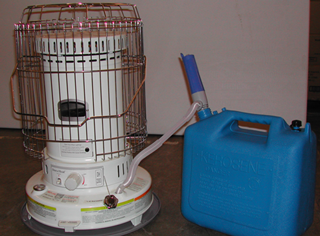Kerosene Heater Inspection
A kerosene heater, also known as a paraffin heater, is a portable, unvented heating appliance that runs on the controlled burning of kerosene. In the U.S., it is used mainly for supplemental heating and for emergency heat during a power outage. In Japan and other countries, it is used as the primary source for home heating.
Kerosene burners operate in a manner similar to kerosene lamps: a fabric wick draws kerosene from a tank via capillary action into a burning chamber mounted above. Once lit, the wick warms nearby objects through radiation and convection. The user may control the burner’s heat by raising or lowering the wick's height inside the burning chamber. The heater is turned off by fully withdrawing the exposed wick into a cavity beneath the burner.
Kerosene heaters are favored for their portability, efficiency and lack of reliance on electricity. They also lack a pressure-fed fuel system, which is a significant safety advantage over standard heating systems. However, the following problems plague kerosene heaters:
- odor. While newer kerosene heaters do not present as much of a problem, all such heaters emit a smell when they are being fueled. Odors typically cease after the heater begins burning normally. If the odor does not dissipate, the cause may be because the wick may be too thin for the heating unit, allowing kerosene vapors to pass through the wick gap and vent into the room. Odors and excess smoke might also result from the combustion of low-grade fuel or contaminated kerosene;
- inadequate ventilation. Kerosene heaters, like ventless fireplaces, vent soot, sulfur dioxide, carbon dioxide and carbon monoxide directly into the living space. In modern, well-insulated homes, an improperly adjusted, improperly fueled, or poorly maintained kerosene heater can pose a serious health hazard; and
- fire hazard. Highly flammable liquids are burned within the living space, creating vulnerability to mechanical and human-made problems.
The aforementioned safety concerns can be addressed by inspecting for the presence of the following safety design features:
- an Underwriters Laboratory (UL) seal, guaranteeing that it has passed certain safety requirements;
- a push-button, automatic starter, which eliminates the need for matches;
- a low center of gravity, which makes accidentally tipping over the burner less likely;
- an automatic cut-off device to turn the heater off in case it is tipped over. This device also prevents kerosene from spilling during a tip-over;
- a grille attached to the front to prevent contact burns;
- placement of the heater on a large, fireproof surface;
- a model that is equipped with a wick -- this makes flooding of the burner impossible;
- all components made from heavy, reliable metal;
- a sturdy fuel tank, sealed and installed beneath the burner; and
- a fuel gauge to prevent inadvertent over-fueling.
Safe-Use Practices
- Burn only water-clear, K1 kerosene that is not yellow or contaminated. While other grades of kerosene may look like K1, they will release more pollutants into the home. Never burn gasoline or any other flammable liquids, as they dramatically increase the risk of fire or explosion.
- Do not use a kerosene heater in areas where explosive vapors may be present, such as in a garage.
- Always store kerosene in a container intended for kerosene and marked as such, and never in a can that has previously contained gasoline. Gasoline containers are typically red, while kerosene containers are usually blue. The container should have a tight-fitting lid to avoid spills. Do not store large amounts of kerosene or any other flammable liquid.
- Never bring kerosene into the house other than the fuel in the heater, which should be filled outdoors after the heater has cooled down.
- Maintain a safe clearance between the heater and furniture, drapes and other combustibles.
- Do not place the heater in a high-traffic area or in the way of an exit.
- Instruct children to never touch the controls, and keep children and pets away from the heater at all times.
- Do not let the heater operate while the house is vacant.
- Ventilate the room by opening a door or window.
- Never move or carry the heater in the event of an explosion or flare-up. Activate the manual shut-off switch, if equipped, in emergencies.

